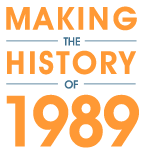About
In 2006, the Roy Rosenzweig Center for History and New Media (CHNM) at George Mason University received funding from the National Endowment for the Humanities to create Making the History of 1989. The project is now complete.
Contact Information Collaborators Cold War International History Project of the Woodrow Wilson
Center Introduction Few images from the second half of the twentieth century endure
as vividly as the jubilant crowds atop the Berlin Wall in 1989, seemingly tearing
down the Cold War with their hammers, hands, and hopes. Just as memorable was
the sight of hundreds of thousands of people filling Wenceslaus Square in Prague,
chanting “Truth Will Prevail” as the communist regime crumbled before
their eyes. These joyful images compete in popular memory with equally powerful
but horrific scenes: the Romanian President, Nicolae Ceausescu, and his wife
executed on live television on Christmas morning, or emaciated Bosnians peering
out from behind prison camp wire following the outbreak of civil war in Yugoslavia.
As rapid as it was unexpected, the collapse of the communist regimes in Eastern
Europe and the period of transition that followed brought the twentieth century
and the Cold War to a close in way few expected. Those who lived through those
days will never forget the sense of seeing “history in the making.” Making the History of 1989 materials were developed
because teachers and their students have little access to vivid historical documents
in English that convey the epochal events of 1989. Project materials utilize
recent advances in our understanding of how historical learning takes place,
including complex interaction with sources, recursive reading, and skills used
by historians. Making the History of 1989 has three key features:
a substantial collection of high quality primary sources; a set of multimedia
interviews that make visible the processes by which historians transform events
and sources into historical narratives; and lesson plans and document based
questions provide historical context, tools, and strategies for teaching the
history of 1989 with primary sources in ways that make “history making”
visible and vivid. Project Team
T. Mills Kelly (Executive Producer and
Principal Investigator) Kelly Schrum (Project Co-Director) Matthew P. Romaniello (Associate Director) Jon Berndt Olsen (Editor) Tom Rushford (Editor) Jeremy Boggs (Creative Lead) Maureen Connors (Graduate Research Assistant) Misha Mazzini Griffith (Graduate Research Assistant) Katherine Gustin (Project Manager) Kristopher Kelly (Web Developer) Kristin May (Research Assistant) Anastasia Mikheeva (Graduate Research Assistant) Liz Moore (Project Associate) Emily Perdue (Research Assistant) Laura Veprek (Web Designer) Misha Vinokur (Media Editor) Pin Wang (Programmer) Gwen White (Project Manager) Savannah Scott (Graduate Research Assistant for Sustainability, 2025) Scholars Bradley Abrams Maria Bucur Padraic Kenney Gale Stokes Vladimir Tismaneanu Introductory Essay Author Elizabeth Clark Teaching Module Authors James Bjork Tom Ewing Cathleen Giustino T. Mills Kelly (see above). Irina Livezeanu Brian Porter-Szucs Lesson Plan/DBQ Authors Jennifer Dikes Laura Thompson Tom Rushford Cynthia Szwajkowski Elizabeth Ten Dyke Case Study Authors Hugh Agnew Melissa Bokovoy David Doellinger Maura Hametz Kevin Deegan-Kraus Jill Massino Basia Nowak Jon Berndt Olsen Matt Romaniello Tricia Starks Elizabeth Ten Dyke Jennifer Walton Editorial Assistance Alan Gevinson Joel Tannenbaum Deanna Wooley
Roy Rosenzweig Center for History and New Media
George Mason University
4400 University Drive, MSN 1E7
Fairfax, VA 22030
chnm@gmu.edu
German Historical Institute, Washington, D.C.
National Czech and Slovak Museum & Library, Cedar Rapids, IA.
National Security Archive
University of Maryland-Baltimore County, Special Collections
Wende Museum, Culver City, CA
